The ASUS Zenbook UX305 Review
by Brett Howse on March 25, 2015 8:00 AM ESTBattery Life
Not everyone requires battery life in a laptop. For some, a laptop is something you move from desk to desk, and can keep power close at hand. However even for those types of people (like me) there are going to be times where battery life is much more important, such as on a long trip. We have seen the bar raised considerably in the last several years with respect to battery life.
The ASUS UX305 has the power sipping Core M processor, whose 4.5W TDP means that the CPU/SoC's power consumption is kept quite low. But that is of course only part of the story. The display is a huge driver in energy use, and as we have seen in recent reviews, high resolution displays, although beautiful to look at, can use much more energy than those that sport a lower resolution. Unlike our Dell XPS review, we do not have both the low and high resolution models available for comparison, so for now we will focus on the 1080p model that is available.
To test battery life, we have two workloads. Our light test is light web browsing, and our heavy test increases the number of pages loaded, adds a 1 MB/s file download, and has a movie playing. We set all displays to 200 nits.
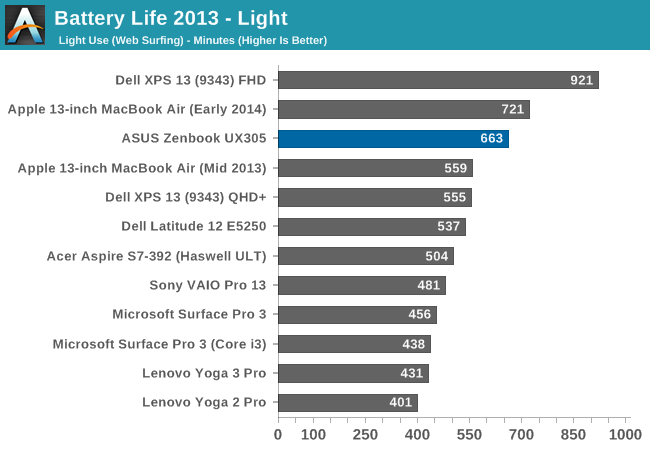
ASUS has packed tremendous battery life into this tiny fanless laptop. At just over 11 hours, it is one of the best results we have seen from any device, and it is all done on just a 45 Wh battery. It is not quite as efficient as the Dell XPS 13, despite the Dell having a 15 watt CPU, but the CPU is just a small part of this test, as it is generally not under much load. To see how the device fares under a heavier load, we will take a look at our Heavy test next.
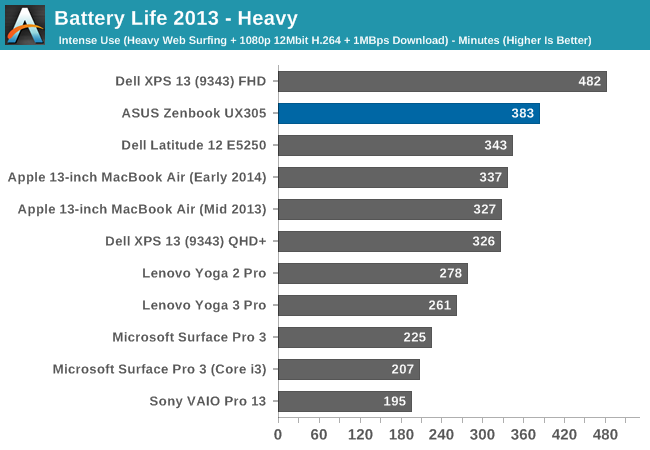
Once again the ASUS performs very well. Despite the thin design, the UX305 has plenty of battery life to handle most workloads with ease. Once more it doesn't quite measure up to the XPS 13, but that device also has a larger battery. To compare all of our devices for energy efficiency with the battery size removed from the equation, we have our normalized graphs.
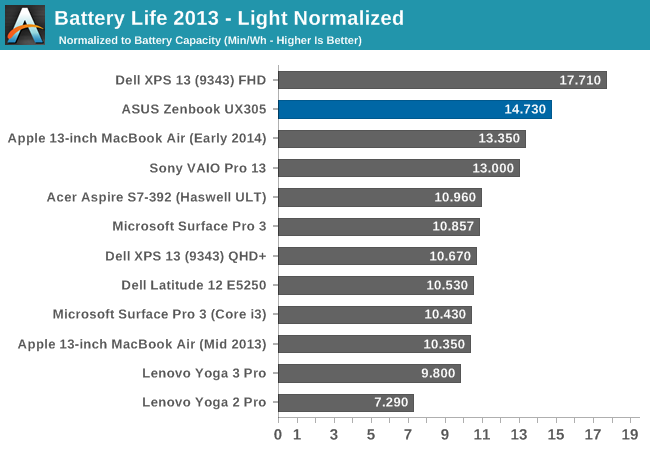
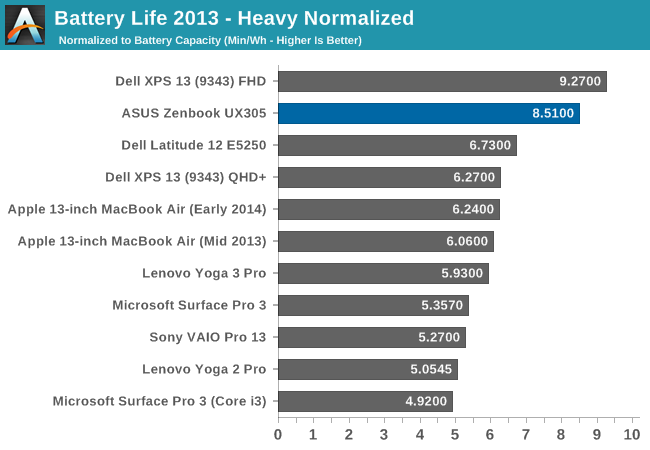
ASUS has done a great job on the overall platform efficiency of the UX305. While not quite class leading, it is quite a bit higher than most devices on the market. With just a 45 Wh battery, the UX305 does an outstanding job.
Charge Time
The other factor in mobility is charge time. Long battery life is great, but if you can top up quickly it can really extend the range of a notebook. The UX305 comes with a 45 watt charger, which seems to be fairly typical these days. There is certainly a trade-off to be made between charging speed and portability, because no one wants to bring a 3 lb charger along with a 2.6 lb notebook.
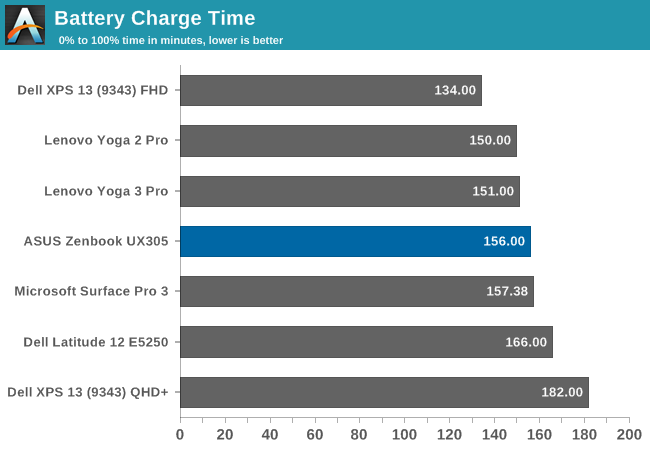
At 156 minutes, the UX305 falls right in line with most devices. Although there is little stopping someone from providing a faster charging rate, it seems most OEMs have settled on at or around this score as a target.
The UX305 charges very consistently, with it only leveling out well after 80% charge.
ASUS would be able to improve these scores with a higher wattage charger, but as compared to its peers it is about the same.
Wi-Fi Performance
ASUS has outfitted the UX305 that we have in for review with the Intel Dual Band Wireless-N 7265 wireless networking chip (not to be confused with the Wireless-AC 7265), which also includes Bluetooth 4.0 support. The change from the 7260 adapter seen predominately last year is a drop in power consumption. With a 2x2:2 design, the 7265 can connect at a maximum of 300 Mbps on 5 GHz. ASUS will be offering an 802.11ac card in the higher priced version of the UX305 which comes with the 3200x1800 display.
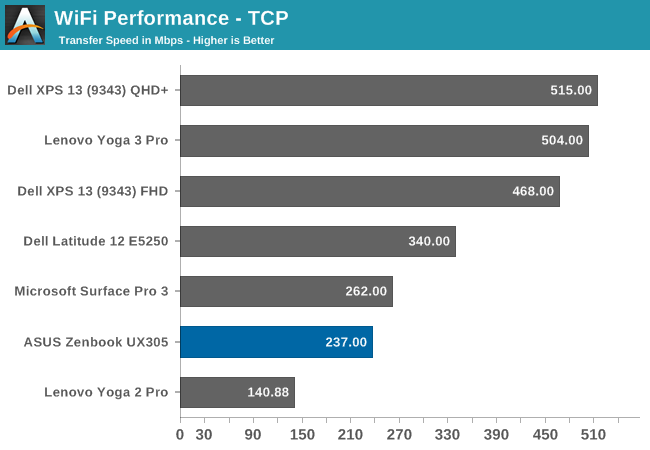
With just 300 Mbps maximum connection speed, the UX305 is sorely outclassed by devices which offer 802.11ac. ASUS is good enough to include a USB 3.0 Ethernet adapter though, for those that require more speed. Using the adapter, I was able to achieve 902 Mpbs transfer rates on our Wi-Fi benchmark. Frankly, I do appreciate the offer, but the money spent on the adapter could have just been used to give the UX305 802.11ac across the board, rather than just on the higher priced model. It is trivial for people to purchase a USB 3.0 Ethernet adapter if they need it, and plug it in, but replacing the Wireless card inside one of today’s laptops is a lot more challenging. This, like the display which raises the laptop, is one decision I have to question about the UX305.
Speakers
In their press materials ASUS has made a big deal about the engineering effort put into the speakers in the UX305, which were developed by the Golden Ear team at ASUS. As stated earlier, the UX305 sports two downward firing speakers, housed in 1.7 cubic centimeter chambers. The speaker dimensions are 25 x 9 x 3 mm and include a “high-intensity” coil. They also include some equalizer software to assist the user in setting the equalizer for various modes, such as VoIP calls, or music.
The audio solution is provided by Conexant and is a 2075x variant, so it should have around 2.8 watts of output power split between the two channels.
All of this being said, playing music I was only able to achieve around 76 dB (A weighted) which is about typical for this type of thin and light device. The outlier here is the Dell XPS 13 which manages 86 dB on the same music track. 10 dB means that the Dell is twice as loud.
However maximum volume is only one side of the equation. We will take a look at the frequency response of the speaker design next.
As you can see from the graph, there is little in the way of low end response, which I suppose is not unexpected for such small speakers. There is really not much in the way of audio response at all until after 200 Hz. There is also a big dip right at 1500 Hz. Overall, these are not the greatest speakers, but they should be fine for watching a few videos. Headphones would be needed for anything where you want to hear the full audio range though.


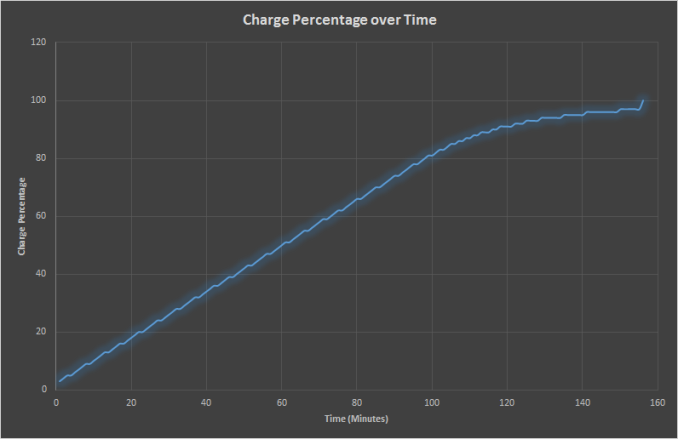
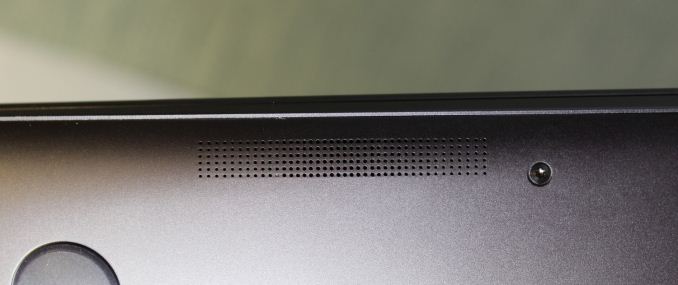
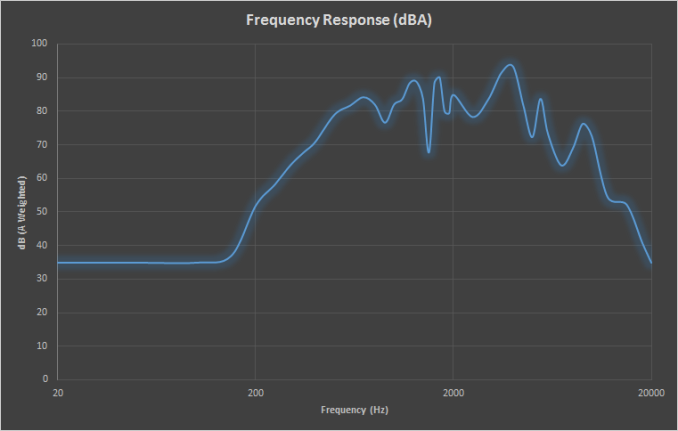








164 Comments
View All Comments
Calista - Wednesday, March 25, 2015 - link
Well, for a lot of people a Core 2 Duo is more than powerful enough. Using a M4400 with a Core 2 Duo T9600 from time to time rarely does it feel slow for "normal usage", i.e. browsing the web, working with Photoshop and whatnot.Once we have reached a certain threshold more performance just doesn't seem so important any more. I would say most folks reached that threshold with the release of the later C2D CPU:s.
FlushedBubblyJock - Wednesday, March 25, 2015 - link
I know many of these people, and replacing the spindle drive with a small SSD (and my usual optimizations in 5 mins) settles it entirely for them.It's faster than the new regulars at the stores.
TheWrongChristian - Thursday, March 26, 2015 - link
I just "upgraded" from my Core Duo T2400 based laptop (which kept up with modern software) to a $60 second hand thinkpad t61, with Core 2 T7100 CPU (which easily keeps up with modern software.)I only upgraded because the screen backlight on the old laptop was a bit flaky, and only upgraded to the thinkpad because it has a fantastic keyboard and I already had the ultrabay HDD adaptor from a previous work laptop, as well as using the same PSU as my old laptop (also a Lenovo.)
Modern machines are let down by their crappy keyboards and screens. That's where the race to the bottom has hit.
TL;DR
I concur. With the push of software down to tablet and smartphones, people have learned to somewhat optimize again, and CPUs performance from ~7-8 years ago is perfactly adequate.
akdj - Saturday, March 28, 2015 - link
Except I'd argue your two biggest concerns (keyboard and screen) are ..at least ½ of the equation ... Of MUCH higher quality, legibility, brightness, contrast, and their corresponding technologies behind them; AMOLED or LCS have come leaps and bounds in the last half to full decade. I'm also intrigued by the new keyboard and trackpad Apple has implementedIf anything, it does seem more Window's OEMs are getting trackpads correct. I can't speak to their keyboards but I've been using solely OS X laptops during that time period you're talking about. Though, during that period Apple's keyboards, again, have only gotten 'Better'. Just MHO, but not a lot of laptops are upgradable either, some 32bit even limited to 3-3.5GB of RAM & nearly impossible to get an SSD inside. That, the SSD today is the ONE differentiator and bottle neck eliminator we've seen. Not the CPU, the RAM, the display or the keyboard. GPU in some cases, sure. But going solid state and fanless without the need for AC all day...for the layman, those are HUGE wins
BrokenCrayons - Thursday, March 26, 2015 - link
I completely agree with the C2D being adequate. For me, "adequate performance" was an upgraded Dell Latitude D620 with a T2300 (1.6 GHz 32-bit dual core), 4 GB of RAM which wasn't fully utilized due to the 32-bit OS and a thing about the 945 chipset that didn't recognize more than like 3.2 GB and a 320 GB non-SSD. It was and still is just fine but the battery was bad, the screen was getting kinda flickery and one of the USB ports was damaged so I bought a used Latitude E6320 with some kind of i5 Sandy Bridge in it and it's far more than I need. While I like the fanless aspects of modern laptops, I hate the short key travel and other sacrifices made in the name of making something thin. It seems pointless and faddish to do that because the laptop still needs just as much space in a handbag or whatever since the other two dimensions aren't different. I'm sure that some people will want something like this, but I can't find a reason to care that much about the thickness. I didn't care when I had a 90 MHz Pentium laptop (which was fanless...Texas Instruments Travelmate 5130..there was a heatsink and this huge heat spreader bar under the keyboard) and I don't worry about it now.074geodude - Wednesday, March 25, 2015 - link
CPU performance wise, no you will not be upgrading.But everything else - screen quality, resolution, thickness, weight, 8 GB RAM, 256 GB SSD, battery life (11+hours, try getting that out of a Core 2 Duo).
It's time to upgrade.
beehofer - Thursday, March 26, 2015 - link
The Core M might not stand much a of chance against the the U but they seem to have a purpose. I would very much like a review of the new more powerful Asus UX303LA which is sporting the 5200U. I got it from the microsoft store for 1300$ after adding a 1TB EVO 850 SSD. the screen is higher ppi than the newest 13 inch macbook pro retina with 8GB of Ram. You can't beat the bang for the buck. Battery life is the only disappointment so far.sonicmerlin - Monday, March 30, 2015 - link
Even the iPad Air 2 has a faster GPU than Core M.FwFred - Monday, June 15, 2015 - link
I'd say the GPUs trade blows, but the Core M has faster CPU, and the Asus has far more storage for an equivalent price.Novacius - Wednesday, March 25, 2015 - link
It's a shame that it hasn't keyboard backlighting and such a poor display calibration. Maybe they'll do better in future iterations. I'm very interested in a Skylake model.